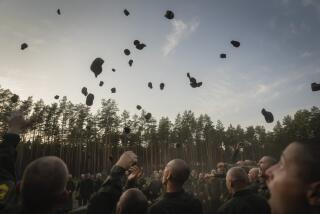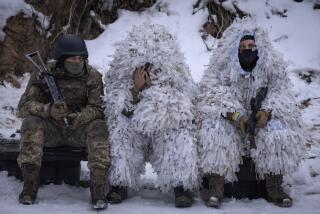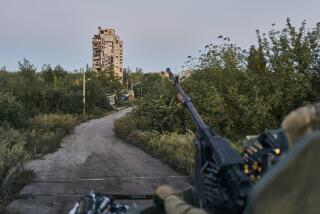Great Read: From foes to brothers in arms: Ukraine police and protesters unite
“Run for cover, everybody; get the hell out of here, on the double!” the leader of the commando unit shouted over his shoulder to the men behind him, his voice echoing eerily in the pitch-black basement. “It is a booby-trap. Watch your step for more wires as you go!”
Panting, swearing, stumbling, falling and rattling with all kinds of firearms, the other fighters rushed to hide behind walls of adjacent rooms, the beams of their flashlights making herky-jerky patterns in the darkness.
------------
FOR THE RECORD:
Ukraine conflict: An article in the July 16 Section A about unlikely allies in the conflict in Ukraine said that the worst day of violence in the anti-government protests was March 20. It was Feb. 20.
------------
As the squad’s explosives expert carefully cut the tiny strings connecting the booby trap inside a Russian army ammo box, Vadim Lisnichuk, the leader of the Ukrainian Interior Ministry unit, gently lifted the lid to find a neatly packed hand grenade.
“One more gift from our big brother up north,” he joked, sweating profusely as the device planted by pro-Russia separatists was being disarmed.
Lisnichuk hasn’t always been a respected combat leader. A few months ago, the 36-year-old had an advertising career in the city of Chernivtsi in western Ukraine. Then he joined the protests in Kiev’s Independence Square, popularly called Maidan, that brought down the government of President Viktor Yanukovich.
“Maidan was a kind of a spiritual festival held on another planet,” Lisnichuk said. “It helped us tear up our puppet strings and feel the taste of real freedom for the first time.”
Armed with sticks, Molotov cocktails and homemade shields, he and thousands of other protesters fought riot police equipped with truncheons, stun grenades and high-caliber rifles in the bloody battlefield that was Maidan.
Now Lisnichuk has joined forces with the same riot police who once opposed him, becoming unlikely comrades in arms against a common enemy: the separatists who until recently made this eastern town their stronghold in their bid to break away from Ukraine and join Russia.
“Little did I know back then that it would end like this,” Lisnichuk said. “But now my weapon is not a stick but a sniper’s rifle and my brothers in arms are not just a motley crew of freedom lovers. We are soldiers now and we will defend our land.”
::
For three months, Lisnichuk and his men in the special forces unit had been trying to dislodge the separatists, who had set up positions in apartments and backyards across Slovyansk, he said. During that time, 258 Ukrainian servicemen were killed, officials said Tuesday.
Finally, more than a thousand insurgents and Russian mercenaries retreated from the city this month, leaving most of their military hardware behind as Ukrainian national guard forces closed in, Lisnichuk said, as he and his men were having a smoke outside amid piles of crushed glass and other debris left by the militants’ hasty exit.
Most of the city’s residents initially supported the separatists, hoping that Russia might annex eastern Ukraine as it did the Crimean peninsula in March. As Lisnichuk and his team did mopping-up operations, the Russian television First Channel news program carried a gory account by an “eyewitness” about Ukrainian troops crucifying a 3-year-old boy in front of his mother in Slovyansk’s central square.
“At first we were afraid to come out and meet our army boys when they came because the Russian television and the [pro-Russia] gunmen down here had warned us that security forces from Kiev would slaughter all the civilian population in town once they came,” said one middle-aged woman, who refused to give her name for fear of being targeted by the separatists.
The Ukrainian forces also had to overcome distrust from within.
As heavy fighting was rolling away from Slovyansk and a national guard battalion was preparing to move toward the separatist-held regional capital, Donetsk, one of the soldiers sat on top of a small hill overlooking a golden landscape of endless fields of sunflowers surrounding the base.
Ivan Datsko, 30, a small-time trader from the western city of Lviv who had fought in Maidan, recalled the carnage at the hands of riot police snipers on March 20 in the square that left about 100 protesters dead. Several police officers were also killed that day, the worst violence of Yanukovich’s rule.
“I will never forget how I crawled up along Institutskaya Street pulling the lifeless body of my friend shot by a sniper bullet,” Datsko said. “It was not a battle, as we didn’t have weapons; it was an execution as bullets came from the ranks of the riot police up the road.”
Soon after Yanukovich fled for Russia at the end of February, pro-Russia armed groups began to seize cities and towns here in the eastern Donbass area, a confrontation that soon unfolded into a real war in the region.
Now Datsko is a member of the national guard, which makes up the bulk of the Ukrainian government forces enforcing law and order in eastern Ukraine.
“At first we were very suspicious of the riot policemen in our forces, as they seemed to be resentful toward us,” Datsko said.
But his baptism by fire against the pro-Russia insurgents changed all that.
One day back in May during heavy fighting, Datsko crawled once again across a battlefield to help another injured fellow fighter — this time a former riot policeman — as another one of his former Kiev opponents emptied his gun in cover fire for Datsko, he recalled.
“A few days later, our helicopter was shot down near Slovyansk, killing our general and several former riot policemen who were on board with him,” Datsko said. “That night we — former Maidan fighters and former policemen — sat together, drank some vodka to the memory of fallen comrades, embraced and swore to each other that we will avenge their deaths.
“And all the previous scores and animosity forever became a thing of the past between us.”
::
Not everybody is euphoric about the newly formed brotherhood in arms of eastern Ukraine.
“It took me years to get military training, and these guys became soldiers overnight,” said national guard Senior Lt. Pavel Fesenko, a former riot police officer.
“We were protecting law and order in Independence Square, and these guys were violating it, throwing Molotov cocktails at us, injuring and killing my comrades,” he said. “I will never trust them not to do some outrageous things again sometime and expose us, the professional soldiers, to unnecessary risks.”
But another member of the riot police expressed admiration for the new soldiers.
“These Maidan guys may be unruly and over-emotional sometimes, but when it comes to business they have no fear. They are born soldiers,” national guard company commander Senior Lt. Serhiy Kovalenko said. “They are not yet properly trained and they need more experience. But if we can teach them a few tricks of the trade they can teach many of us a few things about patriotism.
“I know that I am OK if a former Maidan guy is watching my back in battle, and that is the main thing,” he said. “We are in one boat now.”
As Kovalenko spoke, his national guard base near Slovyansk was swarming with activity as the soldiers were preparing to pull out. Soldiers and officers, most of them shirtless, were reassembling and cleaning their firearms, brushing their boots, shaving their faces and heads.
A passing senior officer heard the men roaring with laughter over one soldier’s off-color joke.
“Good to hear the troops in high spirits,” he said as he made his way through the grounds. “Now I know we are in shape for more fighting!”
The day before, Interior Minister Arsen Avakov visited the national guard base. He praised the valor of its soldiers, awarded a few of them medals and brought 400 new NATO helmets and ballistic vests with him in a bus. He said thousands more helmets and vests would be coming.
As Avakov was making his speech, former Maidan fighters and former riot policemen stood shoulder to shoulder in the parade grounds.
“The real goals and real values they face now change their vision of the world imposed by the former regime,” Avakov said after the ceremony. “What separated them back then was the values of a revolution and the sense of duty; what unites them now is Ukraine’s independence.”
More to Read
Start your day right
Sign up for Essential California for news, features and recommendations from the L.A. Times and beyond in your inbox six days a week.
You may occasionally receive promotional content from the Los Angeles Times.






